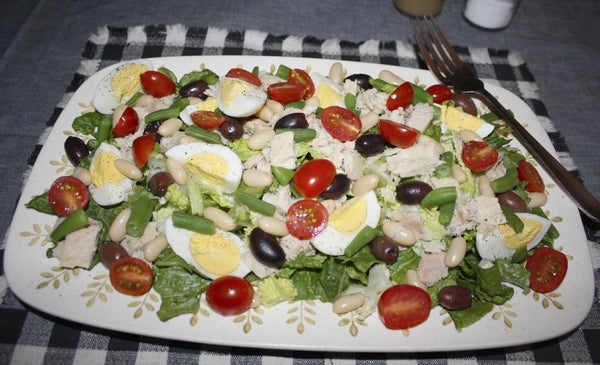Some healthy food alternatives for 2016
Published 12:00 am Tuesday, January 12, 2016

- Stephen Smith/For the Salisbury Post This salad is packed with protein from eggs, tuna and beans, and it's filling.
By Deirdre Parker Smith
deirdre.smith@salisburypost.com
It’s a new year and we’re changing our diets — again. We’re eating lighter, healthier, trying different foods and different cooking methods.
The diet choices are endless, from those gimicky things that require you to eat only two kinds of food for two weeks, to the effective but questionable ones like Atkins, paleo, etc.
Moderation is the key. Less of everything, but more variety. Skinless, boneless chicken breasts are all right, but there’s many other ways to make a lighter meal.
For dinner, the humble cauliflower is staging a coup. First, vegetarians were slicing the cauliflower into steaks that were grilled or roasted. Now, it’s the entire head of the vegetable, roasted, that is appearing as an alternative to roasted meats.
Here’s a recipe from the New York Times, but with alterations. It’s not quick, unless you parboil the cauliflower first. On the other hand, dry-cooking will impart a richer flavor.
The nutrition information shows this:
Nutritional analysis per serving (4 servings)
451 calories; 43 grams fat; 8 grams saturated fat; 0 grams trans fat; 28 grams monounsaturated fat; 4 grams polyunsaturated fat;13 grams carbohydrates; 5 grams dietary fiber; 4 grams sugars; 6 grams protein; 15 milligrams cholesterol; 1231 milligrams sodium
That’s quite a bit of fat, although most of it is acceptable fat. It’s low in carbohydrates and sugar and has a decent amount of protein, but the sodium is unacceptable.
A simple way to reduce that is by eliminating the anchovies, which would also reduce some of the fat. Chopped kalamata olives or capers are a possible substitute, but those, too, have plenty of salt. A little reduced sodium soy sauce will add a depth of flavor. This is served as a main course, so it is a bit richer than a “diet” dish. Instead of basting the cauliflower, you could use an oil mister or cooking spray to make sure the vegetable browns and does not become too dry.
Roasted Cauliflower
1 large cauliflower
Olive oil
Salt
For the sauce:
1/3 cup blanched almonds
2 teaspoons low sodium soy sauce
2 garlic cloves, peeled
2 tablespoons unsalted butter, at room temperature
1/3 cup extra-virgin olive oil
2 teaspoons wine vinegar (white or red), more to taste
1/2 cup coarsely chopped parsley, mint, tarragon, cilantro or a combination
1/2 to 1 teaspoon red pepper flakes (optional)
Salt and ground black pepper
Heat the oven while you prepare the cauliflower: Place a heavy oven-proof skillet (like cast-iron) or a baking sheet in the oven and turn the heat to 375 degrees. Place a small pan of hot water on the rack below, to create steam.
Break off and discard the outer leaves from the cauliflower. Cut off the bottom of the stem, and then use the tip of a small, sharp knife to cut off the leaves close to the stem. Carefully cut out the hard core of the cauliflower, near the bottom. Leave the main stem intact and make sure not to cut through any of the florets.
Rinse the cauliflower (leave the water clinging to the outside) and place on a work surface, core side up. Drizzle with olive oil and use your hands to rub over the cauliflower until evenly coated. Sprinkle with salt.
Place the cauliflower on the hot pan in the oven, core side down, and cook until very tender all the way through when pierced with a knife, at least 1 hour or up to 2 hours. During the cooking, baste 2 or 3 times with more olive oil. It should brown nicely.
Make the sauce: In a small frying pan, toast nuts over low heat, shaking often, just until golden and fragrant. Set aside to cool.
In a food processor, combine almonds, low sodium soy sauce, garlic and butter and pulse until smooth. Mix in oil, then vinegar. Mix in herbs and red pepper flakes, if using. Season to taste with salt and pepper. Set aside.
When cauliflower is tender, remove from the oven. If desired, run it briefly under the broiler first to brown the surface.
Serve cauliflower in the skillet or from a serving plate. Cut into wedges and spoon sauce around each wedge.
The meatiness of mushrooms makes this a filling, but lighter dish. Change out the cheeses if you like. We tried it with a 1/2 cup smoked cheddar and that added to the earthiness of the mushrooms. Good for dinner or lunch.
Mushroom quesadillas
8-inch flour or corn tortillas
1 pound mushrooms, a mix of cremini and white button mushrooms
1/2 medium onion, chopped
1 clove garlic
4 ounces part-skim mozzarella cheese
4 ounces grated Parmeson cheese
1/2 cup chopped cilantro
1/2 tsp dried oregano
1/2 tsp. dried coriander
Slice mushrooms and saute in a medium pan over medium-high heat with a little vegetable or olive oil. Wait for mushrooms to release their liquid and begin to brown, about 10 minutes.
Add onion and saute until soft and entire mixture is browned. Add chopped or minced garlic and saute until fragrant, about 1 minute.
Remove from heat and allow to cool slightly. Transfer to a bowl and add cheeses and herbs. Season with salt lightly — parmesan is a salty cheese — and pepper.
Using a well-seasoned or non-stick skillet, add one more tablespoon of oil. Cover half of tortilla with mushroom mixture, then fold over the other half and add to skillet. turn once, until tortilla is lightly browned and cheese has melted. Alternatively, place on a baking sheet and brown in a 400-degree oven, turning once.
Serve with shredded lettuce, chopped tomato and plain yogurt on the side. Top with salsa if desired.
Serve with a side of black beans, which are packed with potassium and have a good amount o of protein. If using canned beans, drain and rinse to reduce sodium before heating. A splash of lemon juice gives the beans a fresh flavor.
Salads always seem like a great way to cut back and lose weight — but the average chef’s salad, with its ham, turkey, cheese, eggs and dressing can have more calories than a burger.
And let’s face it, you want something that you can put together without a lot of fuss.
This recipe is a an adaptation of a popular French salad, Salade Nicoise, which uses tiny nicoise olives, oil-packed tuna and thin green beans, or haricot verts and tiny boiled new potatoes.
This version is lighter and relies on things you can easily find at the grocery store. If you are in a super hurry, you can buy already boiled eggs, or do it yourself. The protein comes from tuna packed in water and the eggs. Substituting cannelini beans for the potatoes also adds protein and fiber.
Mediterranean Tuna Salad
For a family of 4:
1 large head romaine lettuce in bite size pieces
4 hard-boiled eggs
2 small cans tuna, drained
2 green onions, chopped
1 tomato, chopped
1/2 pound green beans (this is a great time to use those steamer bags)
1 can cannelini beans, drained and rinsed
1/2 cup Kalamata or your favorite olive
Vinaigrette dressing
Boil the eggs first and allow to cool while assembling the other ingredients.
Tear or cut lettuce and arrange on plates or a large platter. Top with tuna which has been broken up with a fork, the onion and the tomatoes. Steam green beans and arrange on the plate.
Make a quick vinaigrette with 1 part red wine vinegar and two parts olive oil, say 1/4 cup vinegar to 1/2 cup oil and one heaping teaspoon Dijon mustard. Using a small whisk or a jar with a lid, mix ingredients until they are smooth and well incorporated. A dash of freshly ground pepper is nice, but since the tuna and olives are salty, be careful with the salt.
Slice eggs and place around the plate, sprinkle with freshly ground black pepper and drizzle all with the vinaigrette.
You could use fresh, seared tuna in place of the canned or change the dressing — but keep it light.





